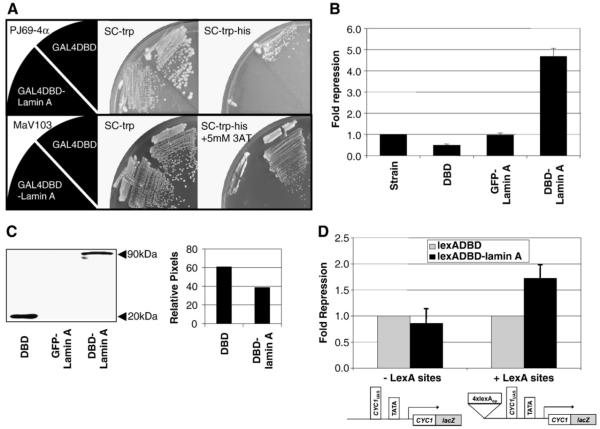Fig. 1.
Lamin A represses transcription in yeast. (A) Plasmids expressing Gal4DBD or Gal4DBD-lamin A was transformed into the yeast 2-hybrid strains PJ69-4α (top panel) or MaV103 (lower panel). Colonies with the plasmids were selected and streaked onto synthetic drop-out plates and incubated for 3 days at 30 °C. SC-trp, synthetic drop-out plate lacking tryptophan. SC-trp-his, synthetic drop-out plate lacking tryptophan and histidine. SC-trp-his+5 mM 3AT, synthetic drop-out plate lacking tryptophan and histidine supplemented with 5 mM 3-aminotriazole. (B) Beta-galactosidase activity from an integrated lacZ reporter was quantitatively measured in yeast strains expressing Gal4DBD, GFP-lamin A or Gal4DBD-lamin A. Fusion proteins were expressed from ARS/CEN plasmids under ADH1 promoter. Results are shown as fold repression over reporter strain (n=3, mean±SD). (C) Western blot analysis was performed to verify the expression of the Gal4DBD-fusion proteins. Protein samples were separated by using SDS-4-20% PAGE and detected by immunoblotting with mouse anti-Gal4DBD. The relative protein levels were determined by counting pixel levels using NIH ImageJ and represented as a percentage of total pixels counted. (D) Repression of integrated lexA responsive lacZ reporters. JK1621 is identical to LG312ΔS except for the presence of 4xlexA operators 5′ to the UAS. LexADBD-fusion proteins were expressed from ARS/CEN plasmids under ADH1 promoter. Beta-galactosidase activity was quantitatively measured and results are shown as fold repression over LexADBD alone (n>3, mean±SD).

